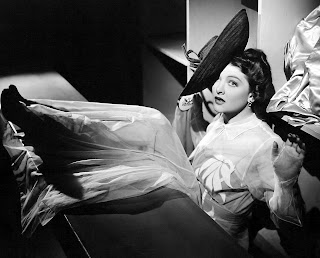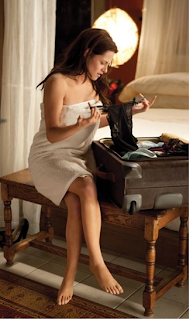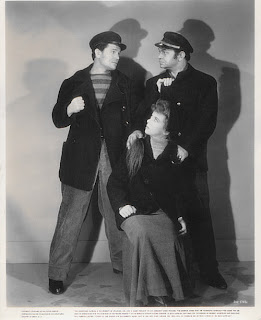 Gloria Dickson (1916–1945) Birth Name: Thais Dickerson
Gloria Dickson (1916–1945) Birth Name: Thais Dickerson Gloria Dickson was established early as one of Warner Brothers leading ingenues. She married Perc Westmore, Warners’ Make-up Artist, and a member of the famous Westmore Cosmetics Family. She began to drink heavily. Perc too was a heavy drinker.
Gloria Dickson was established early as one of Warner Brothers leading ingenues. She married Perc Westmore, Warners’ Make-up Artist, and a member of the famous Westmore Cosmetics Family. She began to drink heavily. Perc too was a heavy drinker. Gloria Dickson and John Garfield had a torrid affair. [while filming "They Made Me A Criminal" directed by Busby Berkely in 1939]
Gloria Dickson and John Garfield had a torrid affair. [while filming "They Made Me A Criminal" directed by Busby Berkely in 1939]Gloria and Perc divorced. Her physical appearance had changed, and soon she was doing character roles. She married twice more; her last husband, an ex-middleweight boxer, was the former bodyguard to Jean Harlow. Tragically, Gloria Dickson died in 1945, just months shy of her 29th birthday in a house fire. Source: classicalmoviechat.com
 14 September 1938 on the set of 'They Made Me a Criminal': "I found that a window in one of the walls built on the sound stage offered the best view of a scene being played by John Garfield, Gloria Dickson and some of the Dead End kids. Soon I was joined by Perc Westmore, head of the makeup department and husband of the actress. We watched several unsuccessful takes of a different scene that was supposed to end in a tender cinch between Miss Dickson and Garfield.
14 September 1938 on the set of 'They Made Me a Criminal': "I found that a window in one of the walls built on the sound stage offered the best view of a scene being played by John Garfield, Gloria Dickson and some of the Dead End kids. Soon I was joined by Perc Westmore, head of the makeup department and husband of the actress. We watched several unsuccessful takes of a different scene that was supposed to end in a tender cinch between Miss Dickson and Garfield. The latter finally came to the window and said, ‘Perc, please get away from there. I can’t make love to a gal while her husband is peeking though a window at us.’ But Westmore wouldn’t move. We both moved, though, when an irate cameraman told us we were in the scene. And sure enough we were —reflected by a mirror on the opposite wall of the set. If any of the earlier takes had been approved, astonished audiences would have noticed a couple of complete strangers peeking through a window and smirking at a heavy love scene." Source: www.glamourgirlsofthesilverscreen.com
The latter finally came to the window and said, ‘Perc, please get away from there. I can’t make love to a gal while her husband is peeking though a window at us.’ But Westmore wouldn’t move. We both moved, though, when an irate cameraman told us we were in the scene. And sure enough we were —reflected by a mirror on the opposite wall of the set. If any of the earlier takes had been approved, astonished audiences would have noticed a couple of complete strangers peeking through a window and smirking at a heavy love scene." Source: www.glamourgirlsofthesilverscreen.com LIFE magazine (January 2, 1939) Ideal Star: "This breathtaking morsel of feminine loveliness, this surpassing goddess of men's dreams is Hollywood's idea of the Ideal Movie Star. Mr. Westmore (Warner Bros' commissar of beauty) with the help of a studio artist he conconcted his Dream Star from parts of four real Warner goddesses: the hair of Gloria Dickson (Mrs. Perc Westmore), the nose of Olivia de Havilland, the lips of Ann Sheridan and the eyes of Priscilla Lane. This composite Venus would be worth at least half a million dollars a year -if she could act". -Oliver Hotspur (Hollywood, CA)
LIFE magazine (January 2, 1939) Ideal Star: "This breathtaking morsel of feminine loveliness, this surpassing goddess of men's dreams is Hollywood's idea of the Ideal Movie Star. Mr. Westmore (Warner Bros' commissar of beauty) with the help of a studio artist he conconcted his Dream Star from parts of four real Warner goddesses: the hair of Gloria Dickson (Mrs. Perc Westmore), the nose of Olivia de Havilland, the lips of Ann Sheridan and the eyes of Priscilla Lane. This composite Venus would be worth at least half a million dollars a year -if she could act". -Oliver Hotspur (Hollywood, CA) Gloria Dickson
Gloria Dickson Olivia de Havilland
Olivia de Havilland Ann Sheridan
Ann Sheridan Priscilla Lane
Priscilla Lane Myrna Loy as Nora Charles in "Shadow of the Thin Man" (1941) directed by W.S. Van Dyke
Myrna Loy as Nora Charles in "Shadow of the Thin Man" (1941) directed by W.S. Van DykeBronx native Irving Brecher (1914–2008) wrote and co-wrote such titles as 'Shadow of the Thin Man' and 'Meet Me in St. Louis' (which earned him an Oscar nomination), 'Somebody Loves Me' in 1952 and the iconic pilot for 'The Many Loves of Dobie Gillis' in 1959.
 Ann-Margret as Kim MacAfee in "Bye Bye Birdie" (1963) directed by George Sidney, screenplay by Irving Brecher & Michael Stewart
Ann-Margret as Kim MacAfee in "Bye Bye Birdie" (1963) directed by George Sidney, screenplay by Irving Brecher & Michael StewartFor his last script, Brecher adapted the satiristic musical 'Bye Bye Birdie' for the screen in 1963. He then retired from show business, eventually writing a memoir detailing his experiences in Hollywood, including his encounters with Milton Berle, Judy Garland, and Fred Astaire. Source: movies.nytimes.com
 -Hank Rosenfeld: "I watched a documentary about the actor John Garfield on Turner Classic Movie channel, and it said he died at 39 when the House Un-American Activities Committee hounded him because his wife was a Communist and he refused to name names".
-Hank Rosenfeld: "I watched a documentary about the actor John Garfield on Turner Classic Movie channel, and it said he died at 39 when the House Un-American Activities Committee hounded him because his wife was a Communist and he refused to name names".-Irving Brecher (screenwriter, director, jokester): "Fuck Turner (TCM), Garfield was on top of a hooker." -"The Wicked Wit of the West: The last great Golden-Age screenwriter shares the hilarity and heartaches of working with Groucho, Garland, Gleason, Burns, Berle, Benny and many more" by Irving Brecher & Hank Rosenfeld (2009)
 Jake Gyllenhaal and Jennifer Aniston as Holden and Justine in "The Good Girl" (2002) directed by Miguel Arteta
Jake Gyllenhaal and Jennifer Aniston as Holden and Justine in "The Good Girl" (2002) directed by Miguel Arteta -Holden: "You're a hooker, you hooker".
-Holden: "You're a hooker, you hooker".
 -Justine: "Holden, calm down! Alright?"
-Justine: "Holden, calm down! Alright?"-Holden: "I can't calm down! Easy if I was a hooker like you then I'd calm down all over town!"
 Jennifer Aniston attends the 'Meine Erfundene Frau' (My Imaginary Wife) photocall at Hotel Adlon on February 21, 2011 in Berlin.
Jennifer Aniston attends the 'Meine Erfundene Frau' (My Imaginary Wife) photocall at Hotel Adlon on February 21, 2011 in Berlin. Here are some highlights from the newly crowned sexiest lady...
Here are some highlights from the newly crowned sexiest lady...-MH: If you could name one woman the sexiest of all-time, who would you have picked?
 -Jennifer: It's a tie between Brigitte Bardot and Gloria Steinem. But if I had to choose one, I'd say Gloria because, well, she's the full package. That's sexy.
-Jennifer: It's a tie between Brigitte Bardot and Gloria Steinem. But if I had to choose one, I'd say Gloria because, well, she's the full package. That's sexy. Marilyn Monroe in "How To Marry A Millionaire" (1953) directed by Jean Negulesco
Marilyn Monroe in "How To Marry A Millionaire" (1953) directed by Jean NegulescoAlso rounding up the top five were Raquel Welch, Marilyn Monroe, Britney Spears and Madonna. Ursula Andress came in at number six with Bettie Page, Pamela Anderson and Jane Fonda taking the next few spots. Source: extratv.warnerbros.com
 Jennifer Aniston is a beautiful woman with an amazing body and an envious lifestyle. But it comes to some amazement that the 42-year-old actress has been named Sexiest Woman of All Time. Men's Health readers voted the former Friends star to the top of the list above many other screen sirens before her who had more bombshell qualities.
Jennifer Aniston is a beautiful woman with an amazing body and an envious lifestyle. But it comes to some amazement that the 42-year-old actress has been named Sexiest Woman of All Time. Men's Health readers voted the former Friends star to the top of the list above many other screen sirens before her who had more bombshell qualities. The 42-year-old actress starred in her most sexual role this year in the movie 'Horrible Bosses' where she played the flirtatious dentist with the filthy mouth. Source: www.dailymail.co.uk
The 42-year-old actress starred in her most sexual role this year in the movie 'Horrible Bosses' where she played the flirtatious dentist with the filthy mouth. Source: www.dailymail.co.uk























































